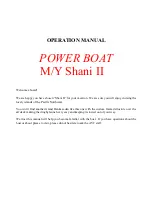
15
ROOF RACK
A kayak carrier, or “J cradle” for your vehicle is the best
method of transporting a kayak. It should be lashed down
at each crossbar, as well as at the bow and stern to each
end of the vehicle. Kayak cradles are recommended for
boats being transported “flat” to lessen chances of
deformation from being lashed too tightly to the bars.
Rotomolded kayaks can be transported on their edge or
upside down (hull up) safely using kayak stackers.
For Composite kayaks we recommend that they be
transported on their bottom using cradles to prevent
deformation. Be careful not to over tighten straps as this
could cause deformation in your boat.
USING FOAM BLOCK RACKS
Foam block racks can be used for transporting kayaks if
extreme caution is practiced in rigging the load. They
should be wide enough for adequate support. The boats
must be securely attached to the top of the vehicle through
the doors or windows and attached securely to both the
front and back of the vehicle. If these tie down points at the
front and back aren’t available on your vehicle, foam block
racks should NOT be used.
INCLEMENT WEATHER
If traveling when inclement weather is threatening, position the
kayak upside down if possible. A kayak heavy with water can
become dangerous. Use a portage cover to seal the cockpit if
an upside down position is not possible. Periodically check your
straps to ensure they have not stretched while wet.
ROTOMOLDED
ROTOMOLDED
COMPOSITE
CAUTION:
Always check your tie down rigging often as ropes and
straps may loosen in transport.
IMPORTANT:
Commander Series requires special transportation instructions.
Please see separate Commander Series Addendum.
TRANSPORTATION
Содержание 2014 Kayak
Страница 1: ...WILDERNESS SYSTEMS OWNERS MANUAL ...








































